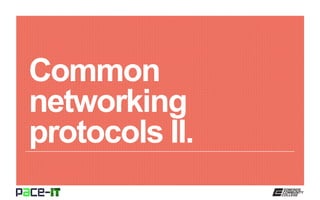
PACE-IT: Common Networking Protocols (part 2)
- 2. Page 2 Instructor, PACE-IT Program – Edmonds Community College Areas of Expertise Industry Certifications PC Hardware Network Administration IT Project Management Network Design User Training IT Troubleshooting Qualifications Summary Education M.B.A., IT Management, Western Governor’s University B.S., IT Security, Western Governor’s University Entrepreneur, executive leader, and proven manger with 10+ years of experience turning complex issues into efficient and effective solutions. Strengths include developing and mentoring diverse workforces, improving processes, analyzing business needs and creating the solutions required— with a focus on technology.
- 3. Page 3 PACE-IT. – The difference between ports and protocols. – Common ports and protocols.
- 4. Page 4 Common networking protocols II.
- 5. Page 5 Common networking protocols II. – Ports. » A method of specifying what protocol or service to access. • Protocols and services use default ports so they are easy to locate. » There are 65,536 ports available to be used for communication, but port 0 is reserved. So, in actuality, only ports 1 to 65,535 are available. • The first 1024 ports are specifically assigned and are called well known ports. • www.iana.org/assignments/port-numbers. » They can also be thought of as phone number extensions. • The IP address is the main number you are trying to reach. • The port is the is the extension (service or protocol) you want to access. – Protocols. » Protocols can be thought of as the language that the two applications on either side of the connection agree to speak. » Protocols translate requests into services. » Most protocols use pre-defined ports, but some protocols must be user configured.
- 6. Page 6 Ports are not protocols and protocols are not ports. Even though the two are closely associated, they are not the same. Ports are used to request (access) services or applications. Protocols are the services or applications that are being requested. When a requestor seeks to connect to a specific port, the requestor is dynamically assigned a port number to “listen to” for the response. This also allows computers to have many concurrent connections. Common networking protocols II.
- 7. Page 7 Common networking protocols II.
- 8. Page 8 Common networking protocols II. – FTP (File Transfer Protocol). » A standard protocol for transferring files between computing systems; requires user authentication. • Assigned to port 20 and to port 21 (mostly uses port 20). – Trivial File Transfer Protocol (TFTP). » Transfers files between servers and clients; no user authentication required. • Assigned to port 69. – SNMP (Simple Network Management Protocol). » A protocol used to monitor and manage local area networks. • Assigned to port 161.
- 9. Page 9 Common networking protocols II. – Telnet. » A protocol used for remote access to systems; it is unsecure. It is a bidirectional terminal service. • Assigned to port 23. – SSH (Secure Shell) » A protocol used to encrypt data traffic on a network; it can be used in place of Telnet to provide a secure bidirectional terminal connection. • Assigned to port 22. – DNS (Domain Name System). » The protocol used to map computer names to their IP addresses (e.g., www.google.com to 74.125.28.104). • Assigned to port 53.
- 10. Page 10 Common networking protocols II. – DHCP (Dynamic Host Configuration Protocol). » The protocol used within networks to automatically configure computers with the correct IP configurations (e.g., IP address, subnet mask, default gateway, and DNS server location). • Requests are assigned to port 67. • Responses are assigned port 68. – RDP (Remote Desktop Protocol). » Used in Microsoft networks by Remote Desktop Connection and Remote Assistance to make remote connections. • Assigned to port 3389. – SMB (Server Message Block). » A protocol used to transfer files over a network; the process is transparent to the user. SMB can be configured to run over NetBIOS on ports 137-139. • Assigned to port 445.
- 11. Page 11 Common networking protocols II. Ports are a method of specifying what protocol or service a requestor is seeking access to. They can be thought of as being the specific location of that protocol or service. Protocols translate the request into a specific service. Of the possible 65,536 ports, 1024 ports are well known (clearly defined as to their purpose). Most protocols are automatically assigned to ports; however, some must have their ports configured by the user. Topic The difference between ports and protocols. Summary Common ports and protocols include: FTP (20 and 21), TFTP (69), SNMP (161), Telnet (23), SSH (22), DNS (53), DHCP (69 and 68), RDP (3389), and SMB (445). Common ports and protocols.
- 13. This workforce solution was 100 percent funded by a $3 million grant awarded by the U.S. Department of Labor's Employment and Training Administration. The solution was created by the grantee and does not necessarily reflect the official position of the U.S. Department of Labor. The Department of Labor makes no guarantees, warranties, or assurances of any kind, express or implied, with respect to such information, including any information on linked sites and including, but not limited to, accuracy of the information or its completeness, timeliness, usefulness, adequacy, continued availability or ownership. Funded by the Department of Labor, Employment and Training Administration, Grant #TC-23745-12-60-A-53. PACE-IT is an equal opportunity employer/program and auxiliary aids and services are available upon request to individuals with disabilities. For those that are hearing impaired, a video phone is available at the Services for Students with Disabilities (SSD) office in Mountlake Terrace Hall 159. Check www.edcc.edu/ssd for office hours. Call 425.354.3113 on a video phone for more information about the PACE-IT program. For any additional special accommodations needed, call the SSD office at 425.640.1814. Edmonds Community College does not discriminate on the basis of race; color; religion; national origin; sex; disability; sexual orientation; age; citizenship, marital, or veteran status; or genetic information in its programs and activities.
